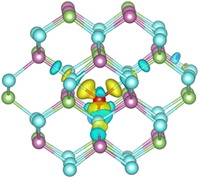Invited Review
Quantum-kinetic perspective on photovoltaic device operation in nanostructure-based solar cells
-
- Published online by Cambridge University Press:
- 11 January 2018, pp. 373-386
-
- Article
- Export citation
Self-assembly monolayers boosting organic–inorganic halide perovskite solar cell performance
-
- Published online by Cambridge University Press:
- 24 January 2018, pp. 387-400
-
- Article
- Export citation
Invited Paper
Dopant–dopant interactions in beryllium doped indium gallium arsenide: An ab initio study
-
- Published online by Cambridge University Press:
- 14 January 2018, pp. 401-413
-
- Article
- Export citation
Carrier-selective contact GaP/Si solar cells grown by molecular beam epitaxy
-
- Published online by Cambridge University Press:
- 28 February 2018, pp. 414-423
-
- Article
- Export citation
Invited Feature Paper
Ceramic composites: A review of toughening mechanisms and demonstration of micropillar compression for interface property extraction
-
- Published online by Cambridge University Press:
- 24 January 2018, pp. 424-439
-
- Article
- Export citation
Reviews
Continuum approaches for modeling radiation-induced self-organization in materials: From the rate theory to the phase field approach
-
- Published online by Cambridge University Press:
- 02 February 2018, pp. 440-454
-
- Article
- Export citation
Invited Feature Paper
Critical role and modification of surface states in hematite films for enhancing oxygen evolution activity
-
- Published online by Cambridge University Press:
- 11 January 2018, pp. 455-466
-
- Article
- Export citation
Articles
Effect of adding Au nanoparticles to TiO2 films on crystallization, phase transformation, and photocatalysis
-
- Published online by Cambridge University Press:
- 14 February 2018, pp. 467-481
-
- Article
- Export citation
Binder-free freestanding flexible Si nanoparticle–multi-walled carbon nanotube composite paper anodes for high energy Li-ion batteries
-
- Published online by Cambridge University Press:
- 11 January 2018, pp. 482-494
-
- Article
- Export citation
The stability, mechanical properties, electronic structures and thermodynamic properties of (Ti, Nb)C compounds by first-principles calculations
-
- Published online by Cambridge University Press:
- 04 December 2017, pp. 495-506
-
- Article
- Export citation
An experimental investigation on B2 phase transfer and grain boundary character on mechanical properties of rapidly cooled Fe–6.5 wt% Si alloy
-
- Published online by Cambridge University Press:
- 04 December 2017, pp. 507-515
-
- Article
- Export citation
Front Cover (OFC, IFC) and matter
JMR volume 33 issue 4 Cover and Front matter
-
- Published online by Cambridge University Press:
- 28 February 2018, pp. f1-f4
-
- Article
-
- You have access
- Export citation
Back Cover (OBC, IBC) and matter
JMR volume 33 issue 4 Cover and Back matter
-
- Published online by Cambridge University Press:
- 28 February 2018, pp. b1-b5
-
- Article
-
- You have access
- Export citation













